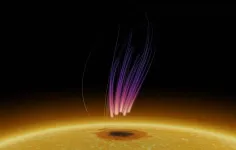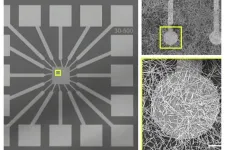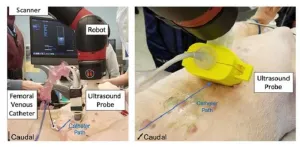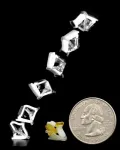(Press-News.org) In a study published in Nature Astronomy, astronomers from New Jersey Institute of Technology’s Center for Solar-Terrestrial Research (NJIT-CSTR) have detailed radio observations of an extraordinary aurora-like display — occurring 40,000 km above a relatively dark and cold patch on the Sun, known as a sunspot.
Researchers say the novel radio emission shares characteristics with the auroral radio emissions commonly seen in planetary magnetospheres such as those around Earth, Jupiter and Saturn, as well as certain low-mass stars.
The discovery offers new insights into the origin of such intense solar radio bursts and potentially opens new avenues for understanding similar phenomena in distant stars with large starspots, according to the study’s lead author and NJIT-CSTR scientist, Sijie Yu.
“We've detected a peculiar type of long-lasting polarized radio bursts emanating from a sunspot, persisting for over a week,” said Yu. “This is quite unlike the typical, transient solar radio bursts typically lasting minutes or hours. It’s an exciting discovery that has the potential to alter our comprehension of stellar magnetic processes.”
Famous auroral light shows that are visible across the sky of Earth’s polar regions, like the Aurora Borealis or Aurora Australis, occur as solar activities disturb Earth’s magnetosphere, which facilitates the precipitation of charged particles to the Earth’s polar region where the magnetic field converges, and interacts with oxygen and nitrogen atoms in the high atmosphere. Accelerating toward the north and south poles, such electrons can generate intense radio emissions at frequencies around a few hundred kHz.
Yu’s team says the newly observed solar radio emissions, detected over a vast sunspot region temporarily forming where magnetic fields on the Sun’s surface are particularly strong, differ from previously known solar radio noise storms — both spectrally and temporally.
“Our spatially, temporally and spatially resolved analysis suggests that they are due to the electron-cyclotron maser (ECM) emission, involving energetic electrons trapped within converging magnetic field geometries,” explained Yu. “The cooler and intensely magnetic areas of sunspots provide a favorable environment for the ECM emission to occur, drawing parallels with the magnetic polar caps of planets and other stars and potentially providing a local solar analog to study these phenomena.”
“However, unlike the Earth's auroras, these sunspot aurora emissions occur at frequencies ranging from hundreds of thousands of kHz to roughly 1 million kHz — a direct result of the sunspot's magnetic field being thousands of times stronger than Earth's.”
“Our observations reveal that these radio bursts are not necessarily tied to the timing of solar flares either,” added Rohit Sharma, a scientist from the University of Applied Sciences Northwestern Switzerland (FHNW) and co-author of the study. “Instead, sporadic flare activity in nearby active regions seems to pump energetic electrons into large-scale magnetic field loops anchored at the sunspot, which then power the ECM radio emission above the region.”
The “sunspot radio aurora” is thought to exhibit rotational modulation in sync with the solar rotation, producing what Yu describes as a “cosmic lighthouse effect.”
“As the sunspot traverses the solar disk, it creates a rotating beam of radio light, similar to the modulated radio aurora we observe from rotating stars,” Yu noted. “As this sunspot radio aurora represents the first detection of its kind, our next step involves retrospective analysis. We aim to determine if some of the previously recorded solar bursts could be instances of this newly identified emission.”
The solar radio emissions, albeit weaker, are likened to stellar auroral emissions observed in the past and may suggest that starspots on cooler stars, much like sunspots, could be the sources of the certain radio bursts observed in various stellar environments.
“This observation is among the clearest evidence of radio ECM emissions we have seen from the Sun. The characteristics resemble some of those observed on our planets and other distant stars, leading us to consider the possibility that this model could be potentially applicable to other stars with starspots,” said Bin Chen, NJIT-CSTR associate professor of physics and a co-author.
The team says the latest insight, linking the behavior of our Sun and the magnetic activities of other stars, could have implications for astrophysicists to rethink their current models of stellar magnetic activity.
“We're beginning to piece together the puzzle of how energetic particles and magnetic fields interact in a system with the presence of long-lasting starspots, not just on our own Sun but also on stars far beyond our solar system,” said NJIT solar researcher Surajit Mondal.
“By understanding these signals from our own Sun, we can better interpret the powerful emissions from the most common star type in the universe, M-dwarfs, which may reveal fundamental connections in astrophysical phenomena,” added Dale Gary, NJIT-CSTR distinguished professor of physics.
The research team — including collaborators Marina Battaglia from FHNW and Tim Bastian of the National Radio Astronomy Observatory — used broadband dynamic radio imaging spectroscopy observations from the Karl G. Jansky Very Large Array to achieve the discovery.
END
NJIT scientists uncover aurora-like radio emission above a sunspot
2023-11-13
ELSE PRESS RELEASES FROM THIS DATE:
Experimental brain-like computing system more accurate with custom algorithm
2023-11-13
FINDINGS
An experimental computing system physically modeled after the biological brain “learned” to identify handwritten numbers with an overall accuracy of 93.4%. The key innovation in the experiment was a new training algorithm that gave the system continuous information about its success at the task in real time while it learned.
The algorithm outperformed a conventional machine-learning approach in which training was performed after a batch of data has been processed, producing 91.4% accuracy. The researchers also showed that memory of past inputs stored in the system itself enhanced learning. In contrast, other ...
Researchers develop gel to deliver cancer drugs for solid tumors
2023-11-13
Intratumoral therapy – in which cancer drugs are injected directly into tumors – is a promising treatment option for solid cancers but has shown limited success in clinical trials due to an inability to precisely deliver the drug and because most immunotherapies quickly dissipate from the site of injection. A team of researchers from Mass General Brigham, in collaboration with colleagues at the Koch Institute for Integrative Cancer Research, has developed a gel delivery system that overcomes these challenges. The gel is injectable but solidifies upon delivery; contains an imaging agent for visualization under CT scan; and can hold a high ...
Using deep learning to process raw photoacoustic channel data and guide cardiac interventions
2023-11-13
Cardiovascular diseases rank among the top causes of death across the world, and cardiac interventions are similarly very common. For example, cardiac catheter ablation procedures, which are used to treat arrythmias, number in several tens of thousands per year in the US alone. In these procedures, surgeons insert a thin, flexible tube called a catheter into the femoral vein in the leg and navigate their way up to the heart, where the problematic tissue is destroyed using cold or focused radiation.
Even though cardiac catheter-based procedures are considered minimally invasive, the position ...
The Long Jump: Athletic, insect-scale long jumping robots reach where others can't.
2023-11-13
A team of engineers from the University of Illinois has published the first known study documenting the long-jumping motion of 3D-printed insect-scale robots.
The new study, published in the journal Smart Materials and Structures, follows a previous publication that documented the same lab’s investigation of vertical jumping in insect-scale robots. The study is led by Professor Sameh Tawfick, an associate professor and Ralph A. Andersen Faculty Scholar in the Department of Mechanical Science and Engineering. His lab, the Kinetic Materials Research Group, studies the ...
UMD engineers’ ‘cooling glass’ blasts building heat into space
2023-11-13
University of Maryland researchers aiming to combat rising global temperatures have developed a new “cooling glass” that can turn down the heat indoors without electricity by drawing on the cold depths of space.
The new technology, a microporous glass coating described in a paper published in the journal Science, can lower the temperature of the material beneath it by 3.5 degrees Celsius at noon, and has the potential to reduce a mid-rise apartment building’s yearly carbon emissions by 10%, according to the research team led by Distinguished University Professor Liangbing Hu in the Department of Materials ...
University of Oklahoma engineer elected as fellow member of Optica
2023-11-13
Optica, an international association in optics and photonics, recently announced the election of University of Oklahoma engineering professor Javier Jo, Ph.D., as a Fellow member.
Jo, a faculty member in the School of Electrical and Computer Engineering, was honored for his contributions to integrating optical imaging and artificial intelligence for biomedical applications. His research focuses on developing optical sensing and imaging technologies to understand pathophysiological mechanisms in human diseases and improve their clinical management.
“Dr. Jo’s ...
University of Toronto Engineering study finds bigger datasets might not always be better for AI models
2023-11-13
From ChatGPT to DALL-E, deep learning artificial intelligence (AI) algorithms are being applied to an ever-growing range of fields. A new study from University of Toronto Engineering researchers, published in Nature Communications, suggests that one of the fundamental assumptions of deep learning models — that they require enormous amounts of training data — may not be as solid as once thought.
Professor Jason Hattrick-Simpers and his team are focused on the design of next-generation materials, from catalysts that convert captured carbon into fuels to non-stick surfaces that keep airplane wings ice-free.
One ...
Acupuncture may offer limited relief to patients with chronic hives
2023-11-13
Annals of Internal Medicine Tip Sheet
@Annalsofim
Below please find summaries of new articles that will be published in the next issue of Annals of Internal Medicine. The summaries are not intended to substitute for the full articles as a source of information. This information is under strict embargo and by taking it into possession, media representatives are committing to the terms of the embargo not only on their own behalf, but also on behalf of the organization they represent.
----------------------------
1. Acupuncture may offer limited relief to patients with chronic hives
Abstract: https://www.acpjournals.org/doi/10.7326/M23-1043
Editorial: ...
Virologic rebound observed in 20% of patients treated with nirmatrelvir-ritonavir
2023-11-13
Embargoed for release until 5:00 p.m. ET on Monday 13 November 2023
Annals of Internal Medicine Tip Sheet
@Annalsofim
Below please find summaries of new articles that will be published in the next issue of Annals of Internal Medicine. The summaries are not intended to substitute for the full articles as a source of information. This information is under strict embargo and by taking it into possession, media representatives are committing to the terms of the embargo not only on their own behalf, but also on behalf ...
One in five patients experience rebound COVID after taking Paxlovid, new study finds
2023-11-13
A new study by investigators from Mass General Brigham found that one in five individuals taking Nirmatrelvir-ritonavir therapy, commonly known as Paxlovid, to treat severe symptoms of COVID-19, experienced a positive test result and shedding of live and potentially contagious virus following an initial recovery and negative test—a phenomenon known as virologic rebound. By contrast, people not taking Paxlovid only experienced rebound about 2 percent of the time. Results are published in Annals of Internal Medicine.
“We conducted this study to address lingering questions about Paxlovid and virologic rebound in COVID-19 treatment,” said corresponding ...




